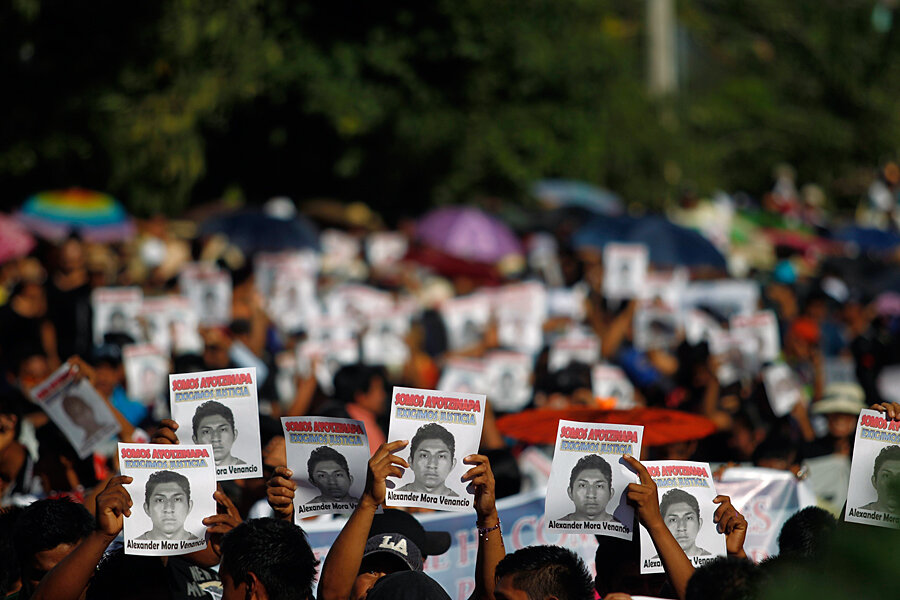DNA test setback: Mexicans still stumped by missing students case.
Loading...
| Mexico City
Nearly four months since the headline-grabbing disappearance of 43 college students in southern Mexico, the victims’ families are still searching for answers.
So far, the DNA of only one student – 21-year-old Alexander Mora – has been confirmed. The Austrian lab working to help identify the pulverized remains said Tuesday they were unable to find any other match. The attorney general asked scientists at the Innsbruck Medical University to retest the remains, which could take an additional three months.
Despite government pledges to hold the perpetrators of this grisly crime accountable, progress has been glacial. But the case isn't likely to fade from public attention: victims' families say they won’t rest until they have concrete proof of their deaths; and scientists have challenged the government's narrative based on testimony from imprisoned gang members.
The 43 students at a teacher's college went missing on Sept. 26 in Iguala, a city in the southern state of Guerrero. According to the government, the students were kidnapped by police officers and handed off to a criminal gang – allegedly on the orders of the town’s mayor, who is now in police custody. The students were allegedly killed, and their bodies burned at a nearby dump. The Mexican government had to reach out to specialists to try to identify the remains.
The subsequent search for the students turned up dozens of unrelated clandestine graves around Iguala, highlighting the lawlessness of the impoverished region. About 100 people have been arrested in connection to the case, including Felipe Rodríguez Salgado, an alleged gang hit man arrested last week.
The Austrian lab results have fueled speculation over whether the government’s account of events is true – and given some relatives hope that their missing loved one could still be alive. The lack of DNA evidence “makes us believe even less in what the government is saying,” Epifanio Alvaraz, the father of 19-year-old missing student Jorge Alvarez, told Bloomberg News.
Families of the victims have pressed the government for access to Army barracks to search for any proof that their children may have been there. The government said last Friday that families could enter an Army base in Iguala. Federal prosecutor Tomas Zeron said earlier this month that there is no evidence troops were involved.
“We are not accusing the Army, we are not saying that they are responsible,” the families’ lawyer, Vidulfo Rosales, said after the Iguala base announcement. “There’s a legal obligation by the public ministry to investigate whether there’s any truth to” rumors that soldiers may have played a role in the events.
Scientific skepticism
It’s not just the victims' families that are skeptical. Two Mexican scientists have published a report challenging the government’s account of events, and specifically how the bodies were allegedly destroyed in a mass cremation. According to a report by McClatchy News:
The attorney general said two gang members had confessed to taking part in the incineration, which they said took more than 15 hours.
“They assigned guards in shifts to make sure the fire lasted for hours, throwing diesel, gasoline, tires, wood and plastic” on the flames, [Attorney General Jesus] Murillo Karam said. He said temperatures had reached up to 2,900 degrees Fahrenheit. In interviews [this month, Jorge] Montemayor and [materials scientist Pablo] Ugalde said the students’ bodies couldn’t have been turned to ash and bone fragments at the Cocula dump.
“They might have cremated 10 people but not 40 or more,” said Montemayor, a physicist at the National Autonomous University of Mexico.
For one thing, the area where the earth shows evidence of fire is too small: 26 feet across. “It’s a tenth of what they would have needed to burn all the bodies,” Montemayor said.
For another, the amount of fuel needed to generate temperatures higher than 1,400 degrees F for incineration would have been enormous.
“You would have needed two trailer beds full of wood,” he said. He added that the area around the dump, at the lower end of a ravine, showed no signs that trees had been felled to feed an enormous fire, or of ashes that a giant fire would have created.
The mass kidnapping and presumed massacre has roiled Mexico, highlighting corruption at all levels of the government and adding to deep-seated beliefs that Mexicans can’t rely on officials to protect them.
Just over half of Mexicans say their country isn’t safe, and nearly 40 percent report their neighborhood is affected by gangs, according to the 2014 AmericasBarometer report published by Vanderbilt University. Regionally, Mexico has one of the lowest levels of citizen satisfaction with local police.
As The Christian Science Monitor reported in December, a sense of citizen insecurity can have larger repercussions:
“When there’s less trust in a justice system, it tends to decrease support for the [government] system as a whole,” says Elizabeth Zechmeister, director of LAPOP at Vanderbilt University. “The exact consequences will vary across countries, but … it’s symptomatic of a system failing to deliver,” she says, adding that citizens may decide to circumvent institutions like the police or courts, as seen in Mexico with the rise of vigilante self-defense groups.
The political upheaval in Guerrero – the state governor resigned in October – along with general instability and violence has led some to question whether or not the state can hold elections in June. Scores of public schools have been closed since last month due to violence, local media report, keeping about 10,000 students of all ages out of the classroom.






